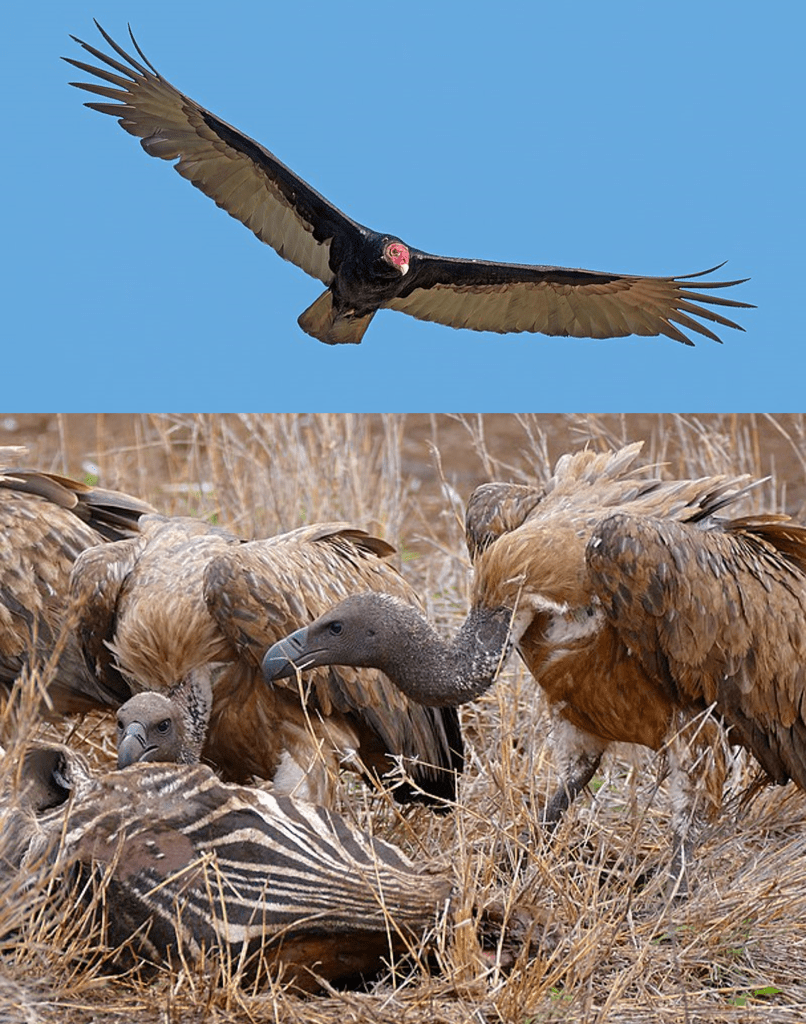Listen to Episode 139 on PodBean, YouTube, Spotify, or wherever you listen to your favorite podcasts!
Lots of animals scavenge from time to time, but very few do it full-time. This episode, we explore the incredible adaptations and ancient history of some of nature’s most extraordinary carrion-eaters, Vultures.
In the news
Multiple new studies explore the mysterious origins of insect wings
This well-preserved trilobite provides clues to how these animals mated
This young Diamantinasaurus is Australia’s smallest known sauropod dinosaur
Study explores what happened to plants during the post-Cretaceous “herbivore gap”
Stupendous Scavengers
Vultures might be the world’s most famous scavengers. They’re pretty diverse, with over 20 living species; they’re widespread, living on five different continents; and they’re really good at being scavengers.

Top middle: King vulture. Image by Eric Kilby, CC BY-SA 2.0
Top right: Bearded vulture. Image by Richard Bartz, CC BY-SA 2.5
Bottom left: White-rumped vulture. Image by Shantanu Kuveskar, CC BY-SA 4.0
Bottom middle: White-headed vulture. Image by Stephen Jones, CC BY-SA 2.0
Bottom right: Hooded vulture. Image by Charles J. Sharp, CC BY-SA 4.0
Surprisingly, vultures are not a single group. Recent studies classify “vultures” into three different evolutionary lineages: New World Vultures (family Cathartidae) and two different groups of Old World Vultures. These groups independently evolved similar adaptations for a life of eating mostly carrion.
Scavenging isn’t easy. Fresh carcasses aren’t always easy to come by, they tend to be full of disease, and they tend to attract competing scavengers. But vultures are beautifully adapted for this not-so-beautiful lifestyle. Their broad wings and keen senses allow them to cover large areas searching for food; their large bodies are not only good for efficient soaring and bullying other scavengers, but also help them store up nutrition to help when food is scarce; and their digestive systems are exceptionally good at destroying disease-causing pathogens. Many animals dabble in scavenging on the side, but vultures excel at it.

Top: Turkey vulture in flight. Image by Charles J. Sharp, CC BY-SA 4.0
Bottom: White-backed vultures feeding on a zebra carcass. Image by Bernard Dupont, CC BY-SA 2.0
As top-tier scavengers, vultures have quite the ecological impact. They keep ecosystems healthy by quickly and efficiently clear carcasses off the landscape, reducing the chance of disease spreading. They even help other animals find food – lots of carnivores have learned to follow vultures to an easy meal.
This ecological importance makes it all the more distressing that vultures are among the most threatened birds in the world. Habitat loss, persecution, and especially the occurrence (intentional and unintentional) of poisons in their ecosystems have led to truly horrifying declines in vulture populations.
Vultures in the Fossil Record
Fossils of both New World and Old World vultures have been found as far back as the Oligocene Epoch, over 20 million years ago, and funnily enough, both groups have fossil representatives in both the New World and Old World. Radiations and extinctions among ancient vultures are often suspected to be linked to the expansion or decline in the ranges of large herbivorous mammals.

Skeleton and diagram of Mioneophron longirostris, a nearly-complete fossil vulture from China. Image from Li et al. 2016.
It’s hard to delve into the vulture fossil record and not come across – and become fascinated by – teratorns. This is a group of extinct birds closely related to New World vultures, which lived in North and South America from the Oligocene to the end of the Pleistocene, just over 10,000 years ago. This group’s most famous members include Teratornis merriami, a large condor-like bird known from over 100 well-preserved Ice Age remains, and Argentavis magnificens, a Miocene species from Argentina that happens to be one of the largest flying birds that ever lived.

Right: Artistic reconstruction of Teratornis merriami by DiBgd, CC BY-SA 4.0
Not Full Yet?
How vultures dine on rotting flesh
Learn more about the threats faced by vultures: here, here
Vanishing Vultures A Grave Matter For India’s Parsis
Analysis of flight in Teratornis and Argentavis (technical)
Is flight necessary for a dedicated scavenger? (technical, paywall)
That vulture fossilized in a pyroclastic flow (technical, paywall)
Bearded vultures in archaeological contexts (technical, paywall)
—
If you enjoyed this topic and want more like it, check out these related episodes:
- Episode 37 – Evolution of Birds
- Episode 6 – Evolution of Flight
- Episode 109 – Hyenas
- Episode 108 – Penguins
We also invite you to follow us on Twitter, Facebook, or Instagram, buy merch at our Zazzle store, join our Discord server, or consider supporting us with a one-time PayPal donation or on Patreon to get bonus recordings and other goodies!
Please feel free to contact us with comments, questions, or topic suggestions, and to rate and review us on iTunes